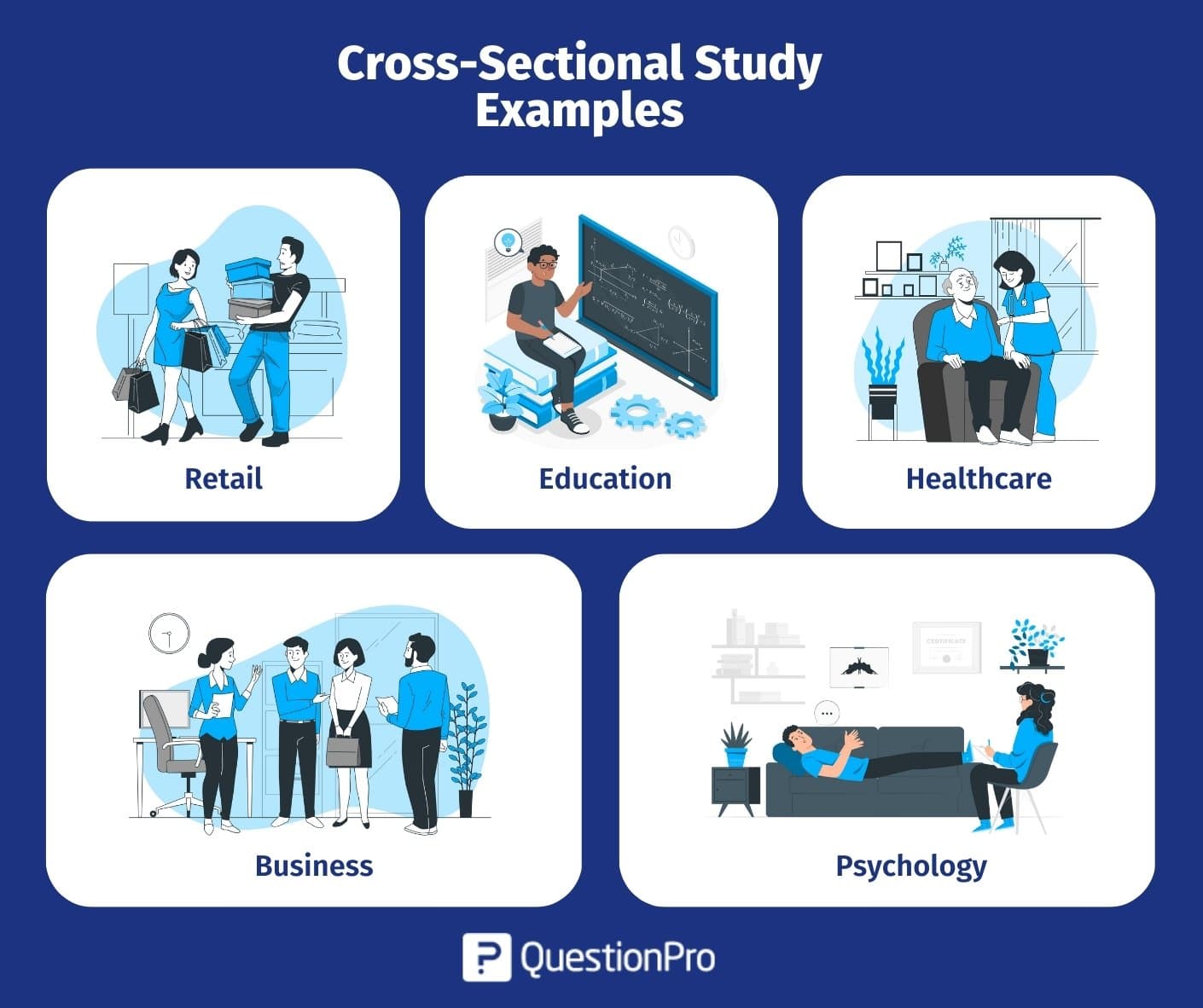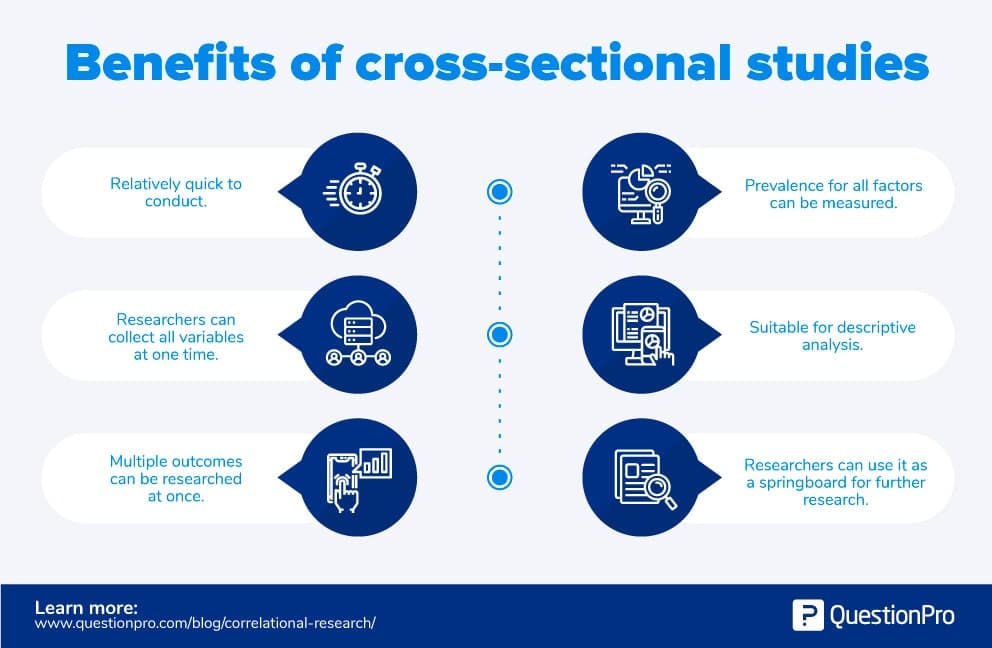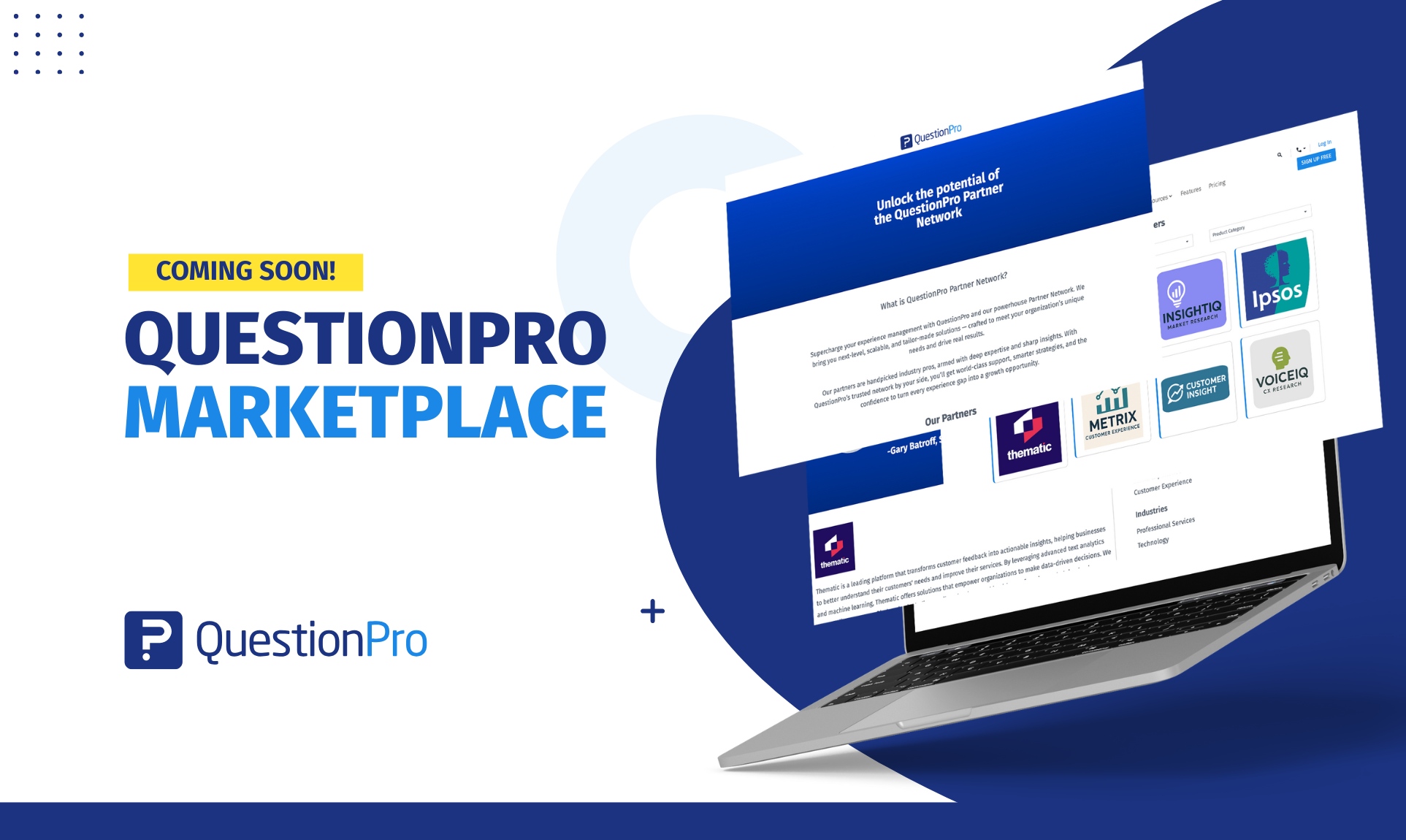
A cross-sectional study is used to collect data from a population simultaneously. It is a snapshot of the population at a particular moment rather than a study that tracks changes over time. This design is often used in fields such as public health, sociology, and psychology to gather information about the characteristics, attitudes, and behaviors of a group of individuals.
This blog will discuss what cross-sectional studies are. We’ll review examples and explain the types of cross-sectional studies you might perform. We’ll also take a closer look at the benefits of this valuable research for the work you do.
What is a Cross-Sectional Study?
A cross-sectional study is a type of observational research that analyzes data of variables collected at one given point in time across a sample population or a pre-defined subset.
This study type is also known as cross-sectional analysis, transverse study, or prevalence study. Although this research does not involve conducting experiments, researchers often use it to understand outcomes in the physical and social sciences and many business industries.
Characteristics of Cross-Sectional Studies
When researchers conduct cross-sectional studies, they look at a specific group of people at a single point in time. Here are some simple characteristics of cross-sectional studies that might help you understand them better:
- Researchers can conduct cross-sectional studies with the same set of variables over a set period.
- Similar research may look at the same variable of interest, but each study observes a new set of subjects.
- The cross-sectional analysis assesses topics during a single instance with a defined start and stopping point, unlike longitudinal studies, where variables can change during extensive research.
- Cross-sectional studies allow the researcher to look at one independent variable and one or more dependent variables as the focus of the cross-sectional study.
Want a fitting metaphor? Think of a snapshot of a group of people at one event, say a family reunion. The people in that extended family are used to determine what is happening in real-time at the moment.
All people have at least one variable in common – being related – and multiple variables they do not share. You could make all kinds of observations and analyses from that starting point. Hence, this research type “takes the pulse” of population data at any given time.
You can also use this type of research to map prevailing variables that exist at a particular given point—for example, cross-sectional data on past drinking habits and a current diagnosis of liver failure.
Cross-Sectional Study Examples
The data collected in cross-sectional studies involves subjects or participants who are similar in all variables – except the one that is under review. This variable remains constant throughout the study. This is unlike a longitudinal study, where variables can change throughout the research. Consider these examples for more clarity:

- Retail: In retail, this research can be conducted on men and women in a specific age range to reveal similarities and differences in spending trends related to gender.
- Education: Cross-sectional studies in school are beneficial in understanding how students who scored within a particular grade range in the same preliminary courses perform with a new curriculum.
- Healthcare: Scientists in healthcare may use cross-sectional studies to understand how children ages 2-12 across the United States are prone to calcium deficiency.
- Business: In business, researchers can study how people of different socio-economic statuses from one geographic segment respond to one change in an offering.
- Psychology: The cross-sectional study definition in psychology is research that involves different groups of people who do not share the same variable of interest (like the variable you’re focusing on) but who do share other relevant variables. These could include age range, gender identity, socio-economic status, and so on.
This research allows scholars and strategists to quickly collect cross-sectional data that helps in decision-making and offering products or services.
Types of Cross-Sectional Studies
When you conduct a cross-sectional research study, you will engage in one or both types of research: descriptive or analytical. Read their descriptions to see how they might apply to your work.
- Descriptive Research: A cross-sectional study may be entirely descriptive research. A cross-sectional descriptive survey assesses how frequently, widely, or severely the variable of interest occurs throughout a specific demographic. Please think of the retail example we mentioned above.
In that example, researchers make focused observations to identify spending trends. They might use those findings to develop products and services and market existing offerings. They aren’t necessarily looking at why these gendered trends occur in the first place. - Analytical Research: A cross-sectional survey investigates the association between two related or unrelated parameters. This research isn’t entirely foolproof, though, because outside variables and outcomes are simultaneous, and their studies are, too. For example, to validate whether coal miners could develop bronchitis, look only at the variables in a mine.
What it doesn’t account for is that a predisposition to bronchitis could be hereditary, or this health condition could be present in the coal workers before their employment in the mine. Other medical research has shown that coal mining is detrimental to the lungs, but you don’t want those assumptions to bias your current study.
Researchers usually use descriptive and analytical research methods in real-life cross-sectional studies.
Benefits of a Cross-Sectional Study
Are you curious whether this research is the right approach for your next study? A Cross-Sectional Survey is an efficient and revealing way to collect data. Check out some of the critical advantages of conducting online research using cross-sectional studies and see if it’s a good fit for your needs.

- Relatively quick to conduct.
- Researchers can collect all variables at a point in time.
- Multiple outcomes can be researched at once.
- Prevalence for all factors can be measured.
- Suitable for descriptive analysis.
- Researchers can use it as a springboard for further research.
If you are looking for an approach that studies subjects and variables over time, you might prefer a longitudinal study. Additionally, you could follow your research with a longitudinal study. It is easy to confuse the two research methods, so we’ve broken it down here:
We recently published a blog that talks about Causal Research; why don’t you check it out for more ideas?
Cross-Sectional vs. Longitudinal Studies
Although they are both quantitative research methods, there are a few differences when comparing and contrasting cross-sectional and longitudinal studies.
| Criteria | Cross-Sectional Study | Longitudinal Study |
|---|---|---|
| Data Collection | Collect data at one point in time. | Collect data at multiple time points. |
| Analysis | Data was analyzed based on within-subject changes. | A shorter time is required. |
| Participants | Different individuals at each point in time. | Same individuals over time. |
| Time | A shorter time is required. | Longer time required. |
| Strengths | Quick and cost-effective. | Tracks individual changes over time. |
| Bias | It may have more bias due to cohort effects. | It may have less bias due to cohort effects. |
| Limitations | Cannot determine causality | Time-consuming and costly |
| Example | A survey of different age groups’ attitudes toward social media. | A study tracking changes in individuals’ attitudes towards social media over time. |
Researchers prefer cross-sectional studies to find common points between variables. Still, they use longitudinal studies, due to their nature, to dissect the research from the cross-sectional studies for further research.
Examples of Cross-Sectional Data
Now that you have a better understanding of what cross-sectional research is and how to perform your studies, let’s look at two examples in more detail:
Example 1: Gender and Phone Sales
Phone companies rely on advanced and innovative features to drive sales. Research by a phone manufacturer throughout the target demographic market validates the expected adoption rate and potential phone sales. In cross-sectional studies, researchers enroll men and women across regions and age ranges for research.
If the results show that Asian women would not buy the phone because it is bulky, the mobile phone company can tweak the design to make it less bulky. They can also develop and market a smaller phone to appeal to a more inclusive group of women.
Example 2: Men and Cancer
Another example of a cross-sectional study would be a medical study examining the prevalence of cancer amongst a defined population. The researcher can evaluate people of different ages, ethnicities, geographical locations, and social backgrounds.
If a significant number of men from a particular age group are more prone to have the disease, the researcher can conduct further studies to understand the reasons. A longitudinal study is best used, in this case, to study the same participants over time.
Create and Analyse a Cross-Sectional Study Survey
It’s your turn! Whether you’re building a marketing strategy or performing a cutting-edge medical study, you can get started by creating an intuitive survey from QuestionPro. Please choose from one of our 350+ survey templates, or build your own and leverage our reporting tools to discover deep insights to apply to your best work.
You can use single-ease questions. A single-ease research question is a straightforward query that elicits a concise and uncomplicated response.
Also, you can find advanced data analysis tools such as trend analysis and dashboards to visualize your information and do your own cross-sectional studies simply and efficiently.
Conclusion
A cross-sectional study provides valuable insights into a population’s characteristics, attitudes, and behaviors at a single point in time. As with any research design, cross-sectional studies should be used with other research methods to provide a complete study. Overall, cross-sectional studies can be a valuable tool for researchers looking to understand a population quickly.
With QuestionPro, you can conduct cross-sectional studies with ease. QuestionPro provides various tools for analyzing your collected data, cross-tabulation, and more. Whether you’re a researcher, marketer, or business professional, QuestionPro can help you gather the data you need to make informed decisions.
Frequently Asked Questions (FAQ)
A cross-sectional study is a type of research that collects data from a group of people at a single point in time to analyze characteristics and relationships.
They are valuable for understanding the current status of a condition or behavior within a population, making them great for initial assessments.
Cross-sectional studies capture data at a one-time point, while longitudinal studies track the same individuals over an extended period to observe changes.
It’s cost-effective, quick to conduct, and provides a broad view of a population’s characteristics or behaviors at a specific time.
The primary goal of a cross-sectional study is to examine and analyze the relationships or associations between different variables within a population at a specific point in time.







